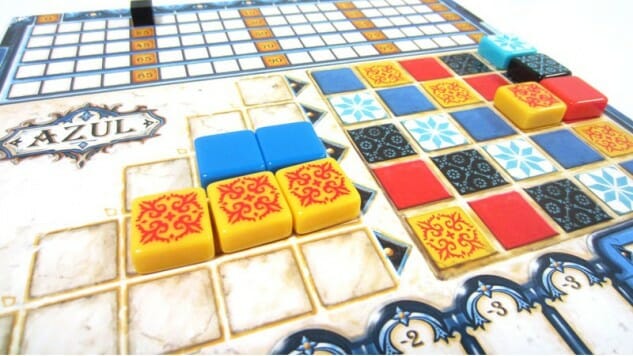It’s Time for Some Game Theory with the Beautiful Azul
Photos courtesy of Plan B Games
Plan B Games is a new publisher with a strong pedigree, as its founder, Sophie Gravel, previously started filosofia Éditions, which grew into the umbrella company F2Z Entertainment as Gravel added Z-Man Games and Plaid Hat to their portfolio. Asmodee acquired F2Z in the summer of 2016, while Gravel left with a few members of her core team to start a new company, Plan B. The imprint’s first release, Century: Spice Road, was a hit at the Origins Game Fair this summer, a light to medium-weight game with a Near East theme and some mechanical similarities to Splendor. Their second title, Michael Kiesling’s Azul, is stronger across the board, a tile placement game that requires you to engage in a little game theory to get the tiles you want and avoid the ones you don’t, with quick playing times and stunning artwork.
Kiesling has many titles under his belt already, including the Spiel des Jahres-winning Torres (just back in print this year from IDW after years in purgatory) and personal favorite Vikings, which came out in 2007 and has appeared in the top 50 of my own all-time boardgame rankings ever since. Azul presents a step up for him in look and feel—the graphics for this game, resembling the mosaic tiles of Moorish architecture, are vibrant and memorable, and the tiles themselves are heavy plastic—with a selection mechanic that reminds me of those of Vikings and Asara (another of Kiesling’s titles), where all players select from a central pool but must plan out their selections to set themselves up for future turns and to try to prevent opponents from getting just what they need.
In Azul, two to four players try to fill out as much of their personal 5×5 tile boards as possible before the game ends when one player finishes an entire row on his/her board. The tiles come in five colors, and each player board has the same preprinted pattern on the 5×5 area, which means you can’t put two tiles of the same color in any row or in any column.
The catch is how you get the tiles from table to board. At the beginning of each round, the dealer places four tiles, drawn randomly from a stylish bag, on each of five to nine “offering” circles (five for two players, nine for four). The start player then takes all tiles of one color from any of the circles, pushing any leftover tiles into the center of the table. Subsequent players may take all tiles of one color from another circle, or may take all tiles of one color from the center; the first player to take tiles from the center becomes the next round’s start player, but will also lose one point at the end of the current round.
Once you’ve taken tiles from a circle or the center, you place them on the left side of your board, which has five blank rows, with one to five empty spaces from top to bottom. You can place the tiles you’ve taken into an empty row, as long as you haven’t already placed a tile of that color in the corresponding row on your 5×5 grid, or can continue to fill a row that already has tiles of the same color. Once you fill the row on the left, any remaining tiles in your hand from that draw must go on the “floor,” a row of spaces at the bottom of your board that carry penalties at the end of the round—one point for each of the first two tiles, two points for each of the next two, and so on. On your turn, you can only place tiles you’ve drawn into one row; you can’t distribute them across multiple rows, even if those rows already have tiles of that color.
